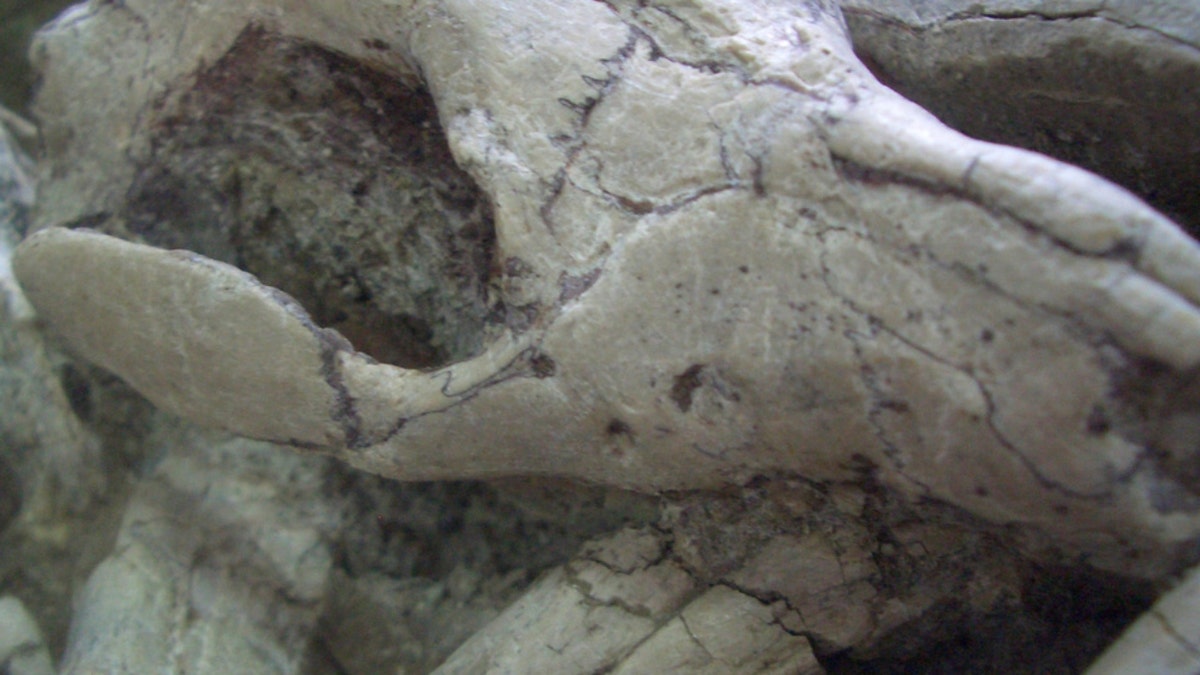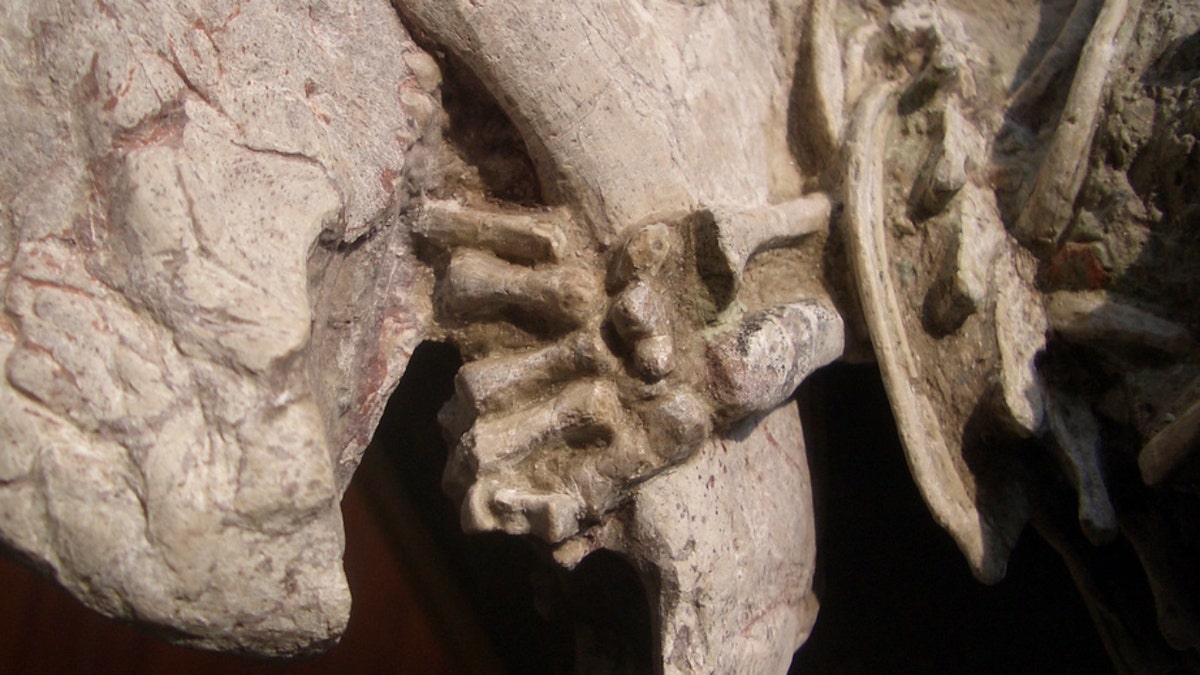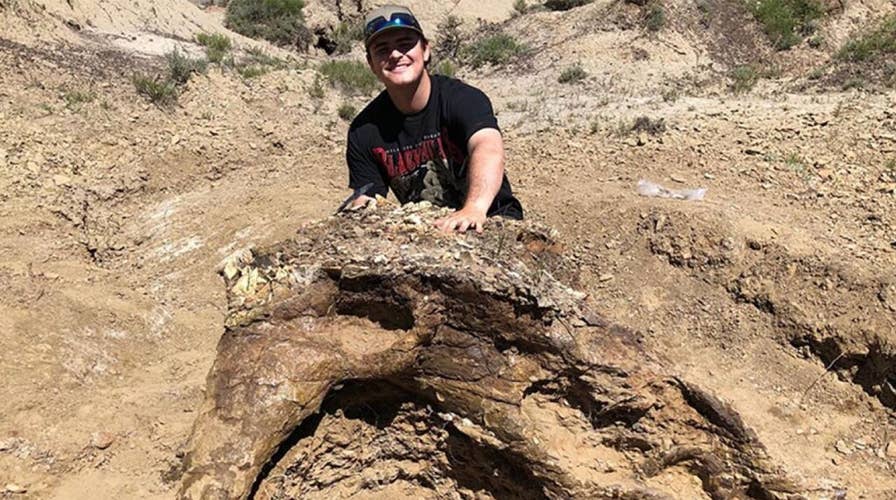College student finds 65-million-year-old fossil of Triceratops skull in North Dakota badlands
65-million-year-old fossil found by a college student.
An unusual fossil found in China suggests that some early mammals may have preyed on dinosaur, according to new research.
The fossil — which is reported to have dated back to around 125 million years ago — was found in China's Liaoning Province in 2012, the Canadian Museum of Nature said in a release.
It comes from an area of fossil beds dubbed "China's Dinosaur Pompeii," referring to the fossils of animals and dinosaurs in the area that had been buried suddenly by mudslides and debris following volcanic eruptions.
The existence of such volcanic material in the study's fossil was confirmed, the museum wrote, after analysis from Canadian Museum of Nature mineralogist Dr. Aaron Lussier.
FOSSIL HUNTER SPOTS 450,000-YEAR-OLD MAMMOTH TUSK WHILE AT QUARRY: 'STICKING OUT LIKE A SORE THUMB'

This image provided by the Canadian Museum of Nature shows entangled dinosaur and mammal skeletons. The scale bar equals 10 cm. The unusual fossil from China suggests some early mammals may have hunted down dinosaur meat for dinner. The fossil shows a badger-like creature chomping down on a beaky dinosaur three times its size. The research published on Tuesday, July 18, 2023, adds to growing evidence that even when dinosaurs ruled the Earth, some mammals were biting back. (Gang Han/Canadian Museum of Nature via AP)
Lussier was one of the authors of the study published Tuesday in the journal Scientific Reports that presented the Canadian and Chinese scientists' findings.
"The two animals are locked in mortal combat, intimately intertwined, and it’s among the first evidence to show actual predatory behavior by a mammal on a dinosaur," Dr. Jordan Mallon, palaeobiologist with the Canadian Museum of Nature and fellow co-author, said in a statement.

This illustration provided by the Canadian Museum of Nature shows a reconstruction of a dinosaur being attacked by a mammal 125 million years ago. ((Michael W. Skrepnick/Canadian Museum of Nature via AP))
The dinosaur in the fossil is identified as a species of a plant-eating Psittacosaurus, which lived in Asia during the Early Cretaceous — or around 105 to 125 million years ago. Psittacosaurus was an early relative of the horned dinosaur lineage, with a parrot-like beak.
The mammal was apparently a badger-like animal called Repenomamus robustus, which was among the largest mammals during that period. It had short limbs, a long tail, a curvy body and shearing teeth.
Before the discovery of this fossil, palaeontologists knew that Repenomamus preyed on dinosaurs including Psittacosaurus because of fossilized baby bones of the herbivore found in the mammal’s stomach, the museum said.

This image of a fossil provided by the Canadian Museum of Nature shows a mammal biting the ribs of a dinosaur. ((Gang Han/Canadian Museum of Nature via AP))
MARYLAND PALEONTOLOGISTS DISCOVER 115-MILLION-YEAR-OLD RARE FOSSIL IN DINOSAUR PARK
"The co-existence of these two animals is not new, but what’s new to science through this amazing fossil is the predatory behavior it shows," Mallon noted.
The fossil was reported to be in the care of co-author Dr. Gang Han, from the Hainan Vocational University of Science and Technology, who brought it to the attention of Canadian Museum of Nature palaeobiologist Xiao-Chun Wu.

This image of a fossil provided by the Canadian Museum of Nature shows the left hind foot of a mammal gripping the left lower leg of a dinosaur. (Gang Han/Canadian Museum of Nature via AP)
The museum highlighted that researchers had ruled out that the mammal was scavenging a dead dinosaur, because the dinosaur bones have no tooth marks and the position of the Repenomamus suggests it was also the aggressor.
The research team speculated that the volcanically derived deposits from the fossil beds in China will continue to yield new evidence of interactions among species.

This image of a fossil provided by the Canadian Museum of Nature shows the left hand of a mammal wrapped around the lower jaw of a dinosaur. (Gang Han/Canadian Museum of Nature via AP)
"The fossil’s presence challenges the view that dinosaurs had few threats from their mammal contemporaries during the Cretaceous, when dinosaurs were the dominant animals," the museum wrote.
The study authors acknowledged to The Associated Press that there have been some fossil forgeries known from this part of the world, which Mallon told the agency was a concern when they started their research.
CLICK HERE TO GET THE FOX NEWS APP
However, after doing their own preparations of the skeletons and analyzing the rock samples, he said they were confident that the fossil was genuine, and would welcome other scientists to study the fossil as well.
Reuters and The Associated Press contributed to this report.


